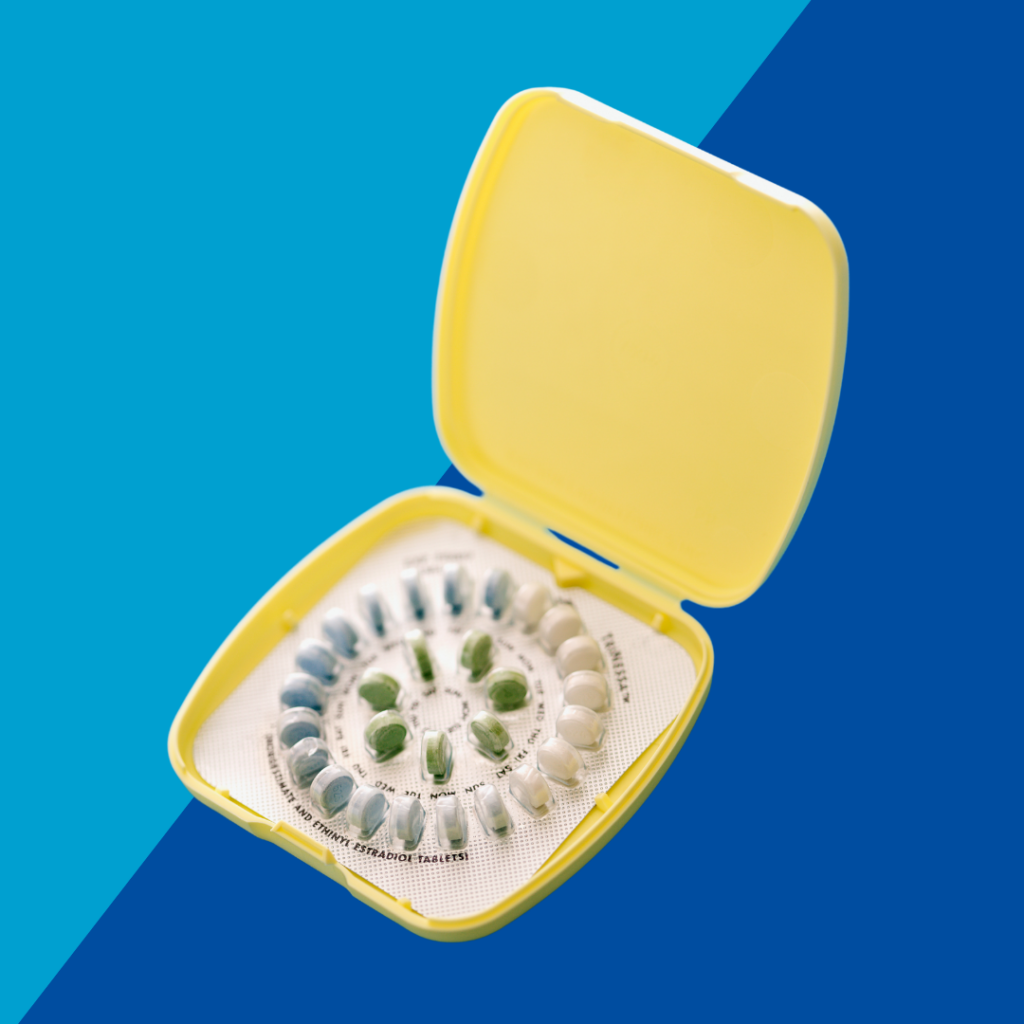Finding the Right Birth Control for You

Did you know that over 90% of women will use at least one type of birth control in their lifetime? Or that 76% of women will use more than one birth control method?
Birth control really is that girl. But whether you’re using birth control to prevent pregnancy, prevent STIs, manage a health condition, or support gender-affirming care—or some combination of all of the above—figuring out which method is right for you can be overwhelming.
- What are the health needs you hope to address with birth control?
- Are you dealing with endometriosis or PMS that no amount of chocolate will help with?
- How does birth control impact your gender identity?
Understanding exactly how each method works can also be… well, a lot.
- How often do you have to take it?
- Would it be hard or easy for you to use it correctly?
- Does it require a doctor’s visit to get started?
- What are the possible side effects?
- Do you want to continue to get your period?
- Do you need a method that no one else will know about?
- Are you willing to use a method that has hormones?
No matter what your answers are to these questions, there’s only one person who should have the final say in your decision: YOU. And if you’re confused, don’t worry, we got you.
Here’s the skinny on how each birth control method works.
Hormonal birth control methods
Hormonal birth control methods work by thickening cervical mucus and preventing ovulation.
- Pill – There are two types of oral contraceptive pills; the most common pills are combined with both estrogen and progestin and the less common is progestin only. The combined pills can treat many other conditions not related to pregnancy prevention such as heavy or irregular bleeding; they are also protective for uterine and ovarian cancers. The combined pill may cause some nausea or breast tenderness early on. Progestin only pills, sometimes called “mini-pills,” are less common but a great option for someone who can’t use estrogen and wants to take daily pills. They are commonly used by people who are breastfeeding. Progestin only pills may cause irregular bleeding and spotting. Pills must be taken at the same time every day.
- Patch – The patch is worn on the skin and changed every week for 3 weeks followed by a week off. The patch has similar benefits and side effects to the combined pills but the active hormones are absorbed through the skin instead of being swallowed.
- Ring – A plastic ring worn inside the vagina that is removed once a month, the ring has similar benefits and side effects to the combined pills and the patch but the active hormones are absorbed through the vagina. Some people use the ring continuously to avoid having periods.
- Shot – The shot is a progestin only method that is injected into the arm, belly, or bum every three months. It may cause spotting and irregular bleeding but some people may not bleed at all. For some, weight changes (gain or loss) may occur.
- Progestin IUD – The IUD is a tiny T-shaped device inserted in the uterus by a skilled provider. It can last from 3-7 years but can be removed anytime sooner. The progestin IUD can cause spotting and irregular bleeding, although some people may eventually not bleed at all. The progestin IUD is also FDA approved for treating heavy bleeding. The IUD is not noticeable to others and doesn’t interfere with tampons or intercourse. The insertion may cause discomfort and cramping. Bonus: it can be effectively used as emergency contraception if inserted within 5 days of unprotected sex.
- Implant – This match size plastic rod is inserted in the underside of upper arm by a skilled provider. The implant can last for 4-5 years but can be removed anytime sooner. The implant may cause spotting and irregular bleeding but some people may eventually not bleed at all.
Non-hormonal birth control methods
Non hormonal birth control methods work by preventing sperm from reaching an egg.
- Condoms – External condoms are rolled on to an erect penis while internal condoms are inserted into the vagina or anus before sex. Condoms are available without a prescription, and are THE ONLY birth control method that also protects against sexually transmitted infections and HIV.
- Cervical cap/diaphragm – This reusable barrier is inserted through the vagina to cover the cervix before sex. It must be used with spermicide to ensure effectiveness.
- Vaginal gel – This new product, called Phexxi, is inserted into the vagina via a pre-filled applicator (similar to a tampon) up to 1 hour before sex. It is only effective for up to 1 hour after insertion so you need to use a new applicator every time you have sex.
- Copper IUD —The IUD is a tiny T-shaped device inserted in the uterus by a skilled provider. It can last up to 12 years but can be removed anytime sooner. The copper IUD may cause heavier bleeding and stronger cramps. The copper IUD is not noticeable to others and doesn’t interfere with tampons or intercourse. The insertion may cause discomfort and cramping. Bonus: it can be effectively used as emergency contraception if inserted within 5 days of unprotected sex.
- Withdrawal – Also known as “pulling out”, this method requires no supplies or hormones and refers to pulling out the penis before ejaculation into the vagina.
- Fertility Awareness – This refers to the practice of tracking daily symptoms to identify days to avoid unprotected sex based on body temperature, cervical mucus, and period cycle. This method can be tracked in an app* or on a calendar and requires no supplies or hormones. It is also a very effective way to track ovulation for anyone trying to get pregnant.
* Following the overturning of Roe v. Wade, there is a growing concern that data from fertility tracking apps could be obtained as evidence to support a criminal prosecution in the event of pregnancy termination or loss. Read more here.
Permanent control methods
Permanent methods are nearly 100% effective at preventing pregnancy.
- Vasectomy – This is a safe outpatient l procedure with a short recovery time that permanently prevent the patient from causing pregnancy by blocking off the small tubes in the scrotum that carry sperm. Three months post procedure, patients must have their semen checked to make sure the vasectomy is fully effective.
- Tubal ligation – This one-time surgical procedure involves cutting or removing the fallopian tubes. The surgery is usually done in a hospital and requires general anesthesia. Recovery time is typically about two weeks.
Emergency contraception
Emergency contraception can be used within 5 days of unprotected sex to prevent pregnancy.
There are two types of pills and two types of IUDs that can be used after unprotected sex. The sooner you use one of these methods, the higher the chance of preventing pregnancy.
Emergency contraception pills (aka “The Morning After Pills”) are available without a prescription and without age restrictions. If you have Medicaid, you can also get it at no cost without a prescription, but you have to ask the pharmacist to “use the standing order for EC”. Another type of pill called (brand name Ella) is more effective for anyone over 155 pounds but requires a prescription.
Both the IUD with progestin (brand name Liletta) or IUD with copper (brand name Paragard) are good options for emergency contraception if you are interested in starting a long-term method.
IMPORTANT NOTE: Emergency contraception pills are NOT the pills used for an abortion. Emergency contraception works by stopping the release of the egg (ovulation) or preventing the egg and sperm from joining, decreasing the chance of a pregnancy.
A note on safe sex
Remember, condoms are the only method that protect against sexually transmitted infections such as herpes, warts, chlamydia, gonorrhea, HIV, etc. It’s always a good idea to use one alongside the birth control method you select.
Explore your birth control options
Still have questions? You can get more detailed information on each method on our Birth Control Options page or download our Birth Control Options one pager for easy reference (also available in Spanish). You can also take our Birth Control Quiz! It’s a fun, super simple way to narrow down your options.
Find a birth control provider near you
If and when you decide that you want to get birth control, you can find a provider by plugging your zip code into our Provider Finder. Remember, anyone in Illinois who is 12 or older can get birth control on their own. If you have any questions, make sure you ask them at your visit! Doctors, nurses, and other folks at the health center are here to help.
So, take control of your health and get connected to the care you need today—because you deserve to be the best version of you. Period hon.




